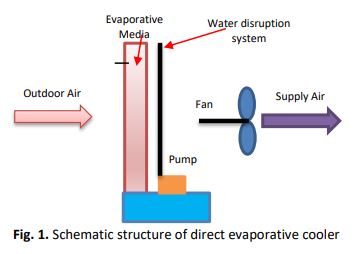Performance of The Direct Evaporative Cooler (DEC) Operating in A Hot and Humid Region of Sabah Malaysia
DOI:
https://doi.org/10.37934/arfmts.93.2.1727Keywords:
direct evaporative cooler, feasibility index, performance, saturation efficiency, cooler capacityAbstract
In the last decade, energy consumption for air conditioning applications has been dramatically rising because of the growing global population and increasing comfort demand. Consequently, direct evaporative cooling (DEC) technology is emerging as an alternative to vapour compression air conditioners due to its lower environmental impacts, less energy consumption, and lower operating costs. This paper aims to verify the experimental results of a direct evaporative cooling system operating under hot and humid climate conditions city of Sabah, Malaysia. The study's aim is to evaluate the efficiency of direct evaporators in hot, humid environments like Malaysia. Inlet and outlet temperatures, saturation efficiency, cooling capability, and feasibility index are all used to evaluate results. The cooling medium was a rectangular honeycomb cooling pad with a length of 34 cm, a width of 25 cm, and a thickness of 3.5 cm. The temperature and humidity during the analysis were between 31 and 35oC and 47.5 and 65.5%, respectively. The results showed that the air output temperature varied between 28.4°C and 31.7°C, while the cooling capacity between 0.29 kW and 0.64 kW as well as the saturation efficiency between 46% to 80% could be achieved. The result also shows that feasibility index between 19 to 24. Due to the high value of the feasibility index, this evaporative cooling does not work well in the territory of Malaysia. A direct evaporative cooler may be made to work in humid places like Malaysia by drying the air before the evaporative process using the desiccant dehumidification concept.Downloads

































